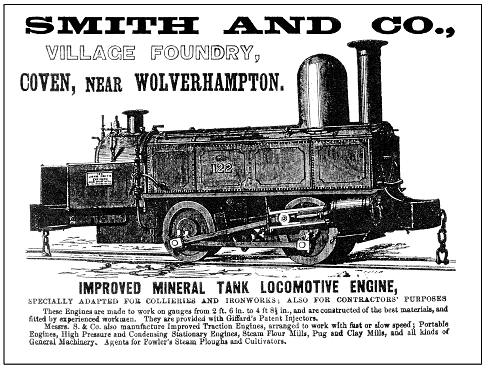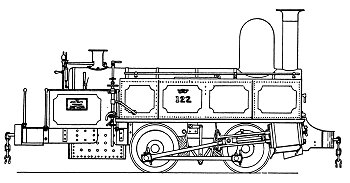Locomotives 1
|
In 1862 Smith and Higgs began to
concentrate on industrial machinery, which was probably more lucrative.
This change in direction was to lead to the manufacture of steam railway
locomotives at Coven.
In 1862 Fletcher, Solly & Urwick of Willenhall Furnaces decided that it was more economical to haul the coal
and iron ore from their mines by locomotive, rather than horses. John
Smith was already well known as a supplier of colliery plant and winding
engines and so he was the obvious person to ask about the construction
of a suitable engine.
|
|

An advert from 1863 showing engine
number 122. |
| John Smith’s first railway locomotive was delivered
to Willenhall around the end of 1862. It must have been successful from the
word go, because a second and larger engine was ordered
and delivered in July 1863. The first engine, an 0-4-0
saddle tank with a Lowmoor iron boiler and copper
firebox, had to have a short wheelbase to cope with two
sharp curves in the track.
The wheels were 2ft 6 inches in diameter and the
wheelbase was just 4 ft. The twin cylinders were 6½ inches in
diameter with a 12 inch stroke. The boiler, which had a
diameter of 2 ft 4 inches, had a steam pressure of 100 lbs per square inch,
and the grate was 1 ft 10 inches by 2 ft 4 inches.
The locomotive ran on track with a gauge of 2 ft 6 inches, and weighed
8 tons. The boiler capacity was 500 gallons. The second
locomotive was also an 0-4-0 tank engine, probably with an
identical boiler. The wheels were also identical, but the
wheelbase was slightly longer at 5 ft 6 inches. The
cylinders were 10 inches in diameter with a 14 inch
stroke, and the engine weighed 9 tons 5 cwt. The smaller
engine was capable of hauling 53 tons up a gradient of 1
in 50, or 14 tons up a gradient of 1 in 30. The larger
engine could haul 30 tons up a gradient of 1 in 20. |
|

0-4-0 tank engine number 122.
|
A third and larger engine was delivered to the
Chillington Iron Company in September 1863. The Wolverhampton
Chronicle described the engine as follows: “the third that
has been built for and started in this neighbourhood by Smith
and Higgs, engineers and machinists of the Village Foundry”.
At least four such engines were purchased by the Chillington
works. |
| Over the next ten years an unknown number of
narrow gauge and standard gauge industrial locomotives were
produced at the foundry. In about 1869 William Harrison’s
Colliery at Brownhills was supplied with a standard gauge 0-6-0
tank engine with 13 inch diameter cylinders, 120 lb per
square inch boiler pressure and an 11 ft wheelbase. The
valve chests were mounted beneath the cylinders and the valves
were held in place by springs. The locomotive was called
“Success” and was broken up in 1913. Two 0-4-0 standard gauge tank engines were sold to
G & R Thomas of Hatherton Furnaces in Bloxwich. The locomotives
called “The Ajax” and “The Vulcan” had outside cylinders, 10
inches in diameter and 3 ft diameter wheels. The locomotives had
no cab, just a weatherboard and the usual high Smith domes. The
chimneys were 5 ft high and the safety valves on the top of the
firebox were adjusted by springs. One of the locomotives was
broken up in about 1914 and the other converted into a steam
winch. |
|

Another view of locomotive number 122. |
|
A narrow gauge 0-4-0 tank engine with
outside cylinders was supplied to the Ashmore Park Colliery near
Wednesfield and an 0-6-0
tank engine with 16 inch diameter cylinders and 3 ft 6 inch diameter
wheels was supplied to the Pelsall Coal & Iron Company. This engine was
delivered from Coven by road, the locomotive being temporarily fitted
with road wheels and horse-drawn. The engine was given a boiler
inspection in 1900 and described as having no coal bunker, but a coal
box in each front corner of the cab. A sandbox occupied part of the rear
of the cab and another was near the front. Two injectors were fitted,
one on each side of the boiler, each feeding from its own tank. The
screw brakes were hand operated and the brake blocks were of wood. The
locomotive continued in use until 1916 and was broken up during the next
few years. It may be that the company had a second such locomotive.
There were rumours that a Smith
locomotive was hired by the LNWR at Bushbury and that another was sent
to Stafford.
|

|
|

|
|

|
Return to the
Previous page |
|
Return to
the contents |
|
Proceed to
the next page |
|